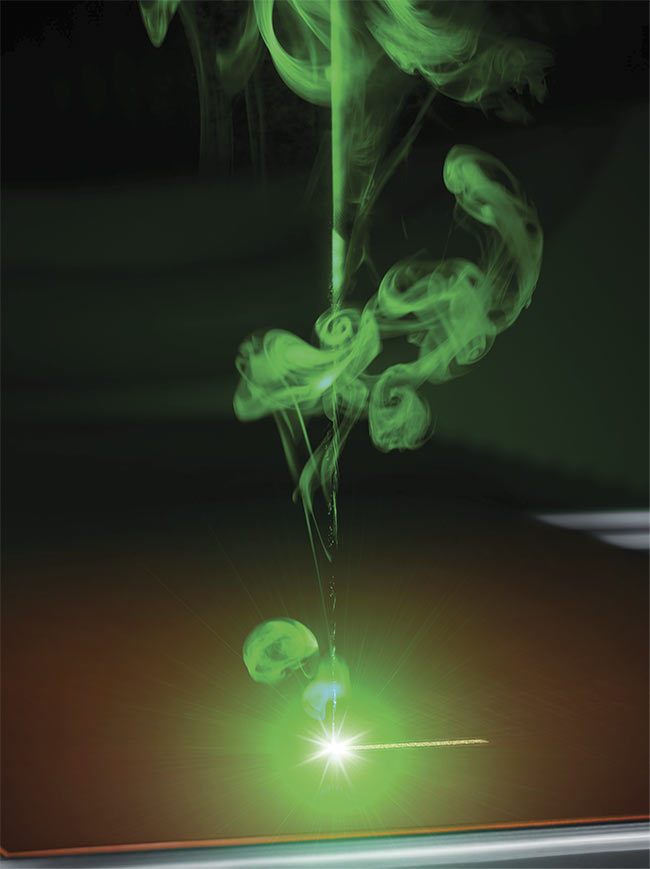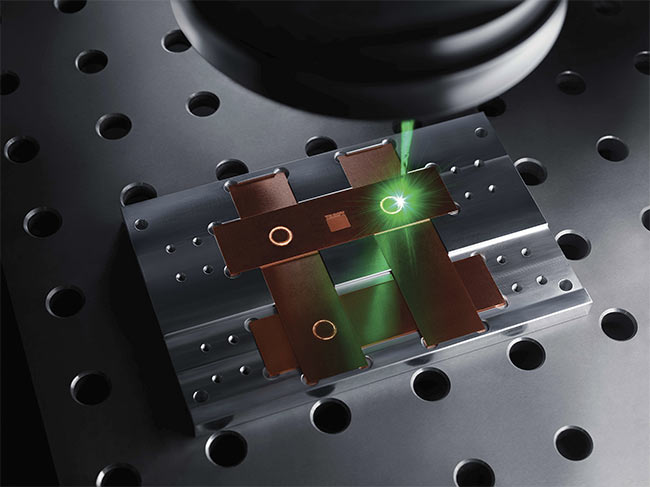Innovations in laser packaging, wavelength, and power are poised to spur developments in materials processing and batteries.
HANK HOGAN, CONTRIBUTING EDITOR
With their performance rising, semiconductor lasers may be able to best their fiber-based counterparts in a wide variety of applications. On the horizon are potential game changers, such as high-power blue laser diodes and organic laser diodes. But innovations are being made in fiber and other types of lasers as well. The overall result for these light source technologies is a drop in the cost per watt delivered, more wavelengths, higher power, and other improvements.
An example of the advancements underway can be seen in products from Japan-based Sharp Fukuyama Laser Co. Ltd., a recently formed subsidiary of Sharp’s diode laser business. According to general manager Yasuaki Hirano, Sharp Fukuyama Laser is focused on increasing efficiency and power in the IR and RGB spectral regions for applications such as pumps for telecommunications fiber lasers and light sources for displays.

Greater power at shorter wavelengths, as offered by this green laser, is helping to improve materials processing performance, particularly for highly reflective metals such as copper. Courtesy of TRUMPF.
The company projects a more than
10% increase in efficiency in the conversion of energy (incoming) into light
(outgoing) for high-power output lasers, with the parameter rising from 41% in 2019 to 45% by 2025. Even so, Hirano said, the expected increase in power means that more heat needs to dissipate.
The solutions the company has under development, Hirano said, include
“realizing higher density with multichip packaging, or MCP, and the adoption
of new materials, such as higher heat-transmitting monocrystal silicon carbide, for the packaging submount.”
Innovations in packaging are indeed necessary, and research and development
in this area is ongoing, according to Takenori Omiya, business promotion
section chief for the laser division of Hamamatsu Photonics KK. The Japan-based company makes an array of semiconductor lasers with wavelengths ranging from as short as 700 nm in the near-IR to 10 μm in the thermal IR.

Materials processing of copper, such as welding (a key part of lithium-ion battery manufacturing), can benefit from high-power green disk lasers or high-power blue diode lasers that meet requirements for beam quality, cost, and system uptime. Courtesy of TRUMPF.
The overall need, no matter the laser application or technology, is to improve brightness, output, and efficiency in a balanced manner.
One motivation for making innovations
in packaging is the drivers — both human and robotic — that pilot vehicles. Distance ranging via lidar is a fast-growing application for vehicles, in which temperature extremes, vibration, dust, and oil could harm laser system performance. Still, lasers must achieve the highest efficiency possible with short pulses of high beam quality.
“It is important to balance not only the optical properties but also the electrical properties,” Omiya said. “In addition, due to the need for high reliability, especially in extreme automotive environments, the right packaging will be crucial.”
Discussing the various laser technologies, he said diode lasers often exceed the power of fiber lasers. So, for some materials processing and other applications, a diode laser can be used. If beam quality is important, though, a fiber laser or a fiber-coupled diode laser may be necessary because these devices produce a higher-quality beam.

A rendering of an organic blue laser diode, showing injected carriers recombining to create blue emission as demonstrated by researchers at Kyushu University. Courtesy of Kyushu University.
The overall need, no matter the laser application or technology, Omiya said, is to improve brightness, output, and efficiency in a balanced manner, with ever smaller semiconductor lasers making it harder and harder to get rid of excess heat. He added that progress in MEMS and nano-optics could have a significant impact on laser technology and systems
in the long run.
Various wavelengths
In addition to packaging, other areas
of laser innovation include wavelength and power. A change to wavelength can make increased power more effective because materials absorb more energy at one wavelength compared to another.
An illustration of a wavelength-related benefit comes from TRUMPF GmbH + Co. KG of Ditzingen, Germany. The
company makes disk, fiber, diode, and other laser systems. In March 2019, TRUMPF debuted a green emission disk laser with kilowatt output power. One of its main application targets is copper processing.
“Its high brightness in combination with the green wavelength enables, for example, remote welding applications with previously unmatched weld quality reproducibility,” said Evangelos Papastathopoulos, product manager for fiber and diode direct lasers.
According to Papastathopoulos, the working lifetime of the green disk laser is 3× that of state-of-the-art high-power blue diode lasers. A long lifetime is important in industrial applications because uptime needs to be as high as possible to better support round-the-clock operations.
Long term, Papastathopoulos said various wavelengths will be used for materials processing. With differing materials and various levels of dopants within those materials, vendors can select for appropriate and more effective emission wavelengths. This allows laser manufacturers to potentially produce solutions in the green, blue, or even shorter wavelengths. These products, however, must meet targets for beam quality, power level,
and lifetime.
The advent of wavelengths in the blue and green, in addition to the need for
further innovation in these spectral regions, is likely to be pushed by the growing volume of lithium-ion battery production. This production is expected to rise substantially as the world’s vehicle fleet electrifies and energy storage systems proliferate. Mordor Intelligence forecasts a 22% CAGR (compound annual growth rate) in the battery market over the next five years, which translates to an even faster growth in volume because of falling prices1.
Power
Copper welding is a key part of the lithium-ion battery manufacturing process. Today, such welding is often done ultrasonically. One reason this method is used is that copper’s high reflectivity results in poor absorption of light above 1000 nm, which is the output wavelength of fiber and many diode-pumped solid-state lasers used in materials processing. In contrast, copper’s absorption of blue light is an order of magnitude greater than that of the fiber laser operating point, which is in the near-IR.
At present, the most common blue
laser diodes are found in Blu-ray players, which use low-power gallium-nitride-based lasers operating at 405 nm to extract data from optical disks. With an eye toward materials processing, companies are working to develop high-power, high-reliability, long-lifetime lasers based on nitride semiconductors that emit at
450 nm.
Papastathopoulos predicted that, in addition to wavelength and power, laser advancements will come in beam delivery and control. He pointed to TRUMPF systems that use fibers with multiple cores to get the beam to the target. For example, there may be a bright center spot with surrounding spots that treat the surface before or after the center spot does the bulk of the materials processing, with this stepped approach being achieved by moving the multiple spots over the workpiece. The result of arrangements such as this and dynamic varying of beam parameters can be higher performance, particularly if combined with sensors and leading-edge control schemes.
“The technology is moving away from a simple light source and becoming more sophisticated,” Papastathopoulos said.
Materials
Finally, in addition to industrial development efforts, research in laser innovations that involves new material systems is underway at academic institutions. For instance, in a 2019 Applied Physics Express paper2, professors Atula Sandanayaka and colleagues, of Japan’s Kyushu University, reported promising results in the development of an organic semiconductor laser diode. They demonstrated lasing using a highly efficient light-emitting material for a gain medium and a grid device structure to inject electricity into that material. This could be an important step toward a future organic laser diode technology. “Any class of lasers needs both a gain material and an appropriate resonator structure,” said Sandanayaka, the paper’s lead author. “Further work should involve the design and development of new efficient lasing materials with [fewer] optical losses.”
Cutting the optical losses will decrease the threshold needed to induce lasing. This advancement can be achieved by adjusting the material composition and structure. “I expect 10 times lower threshold by optimizing various parameters,” research leader Chihaya Adachi said. “For uses, display and medical application would be really promising.”
An organic semiconductor laser could be tuned, through material changes, to emit anywhere from the blue to the near IR, he added. What’s more, the laser material could be deposited into flexible thin films that conform to curved surfaces.
In addition to display and medical applications, other possible uses include sensing and spectroscopy. The startup KOALA Tech Inc. is commercializing this laser technology, aiming, among other efforts, to develop near-IR organic semiconductor lasers for biometric authentication.
KOALA Tech CEO Jean-Charles
Ribierre, another of the paper’s co-authors, said applications of the new technology will exploit the advantages that organic materials offer over current laser systems. This example of innovation boosting laser performance has the potential for an outcome that cannot be predicted today.
“The organic laser diode technology is expected to not only replace the existing inorganic laser technology for some specific applications but will also lead to the development of completely new applications and thus new markets,” Ribierre said.
References
1. Mordor Intelligence (2018). Lithium-ion battery market — growth, trends, and forecast (2019-2024), www.mordorintelligence.com/industry-reports/lithium-ion-battery-market.
2. A.S.D. Sandanayaka et al. (May 31, 2019). Indication of current-injection lasing from an organic semiconductor. Appl Phys Express, Vol. 12, Issue 6, www.iopscience.iop.org/article/10.7567/1882-0786/ab1b90.